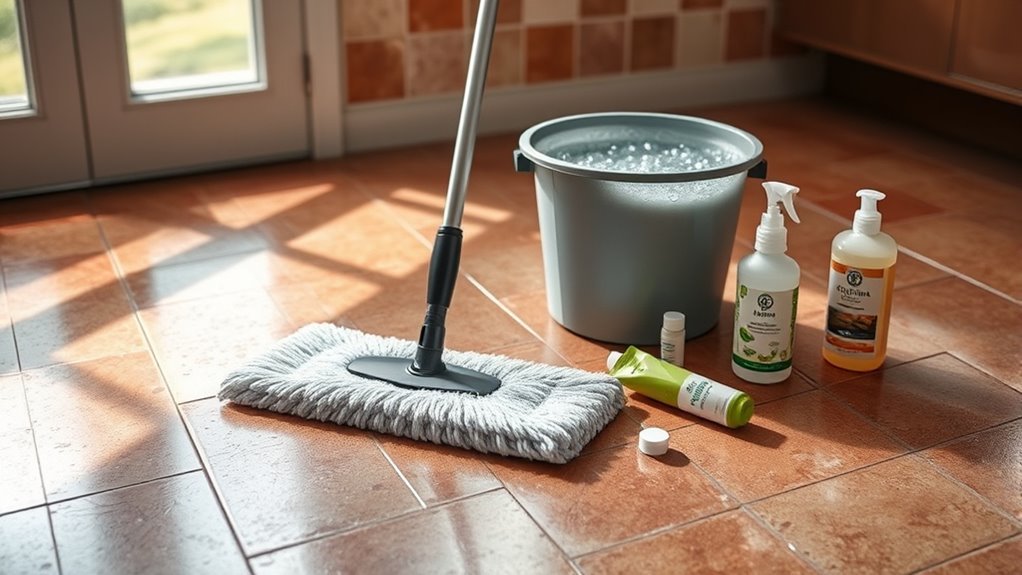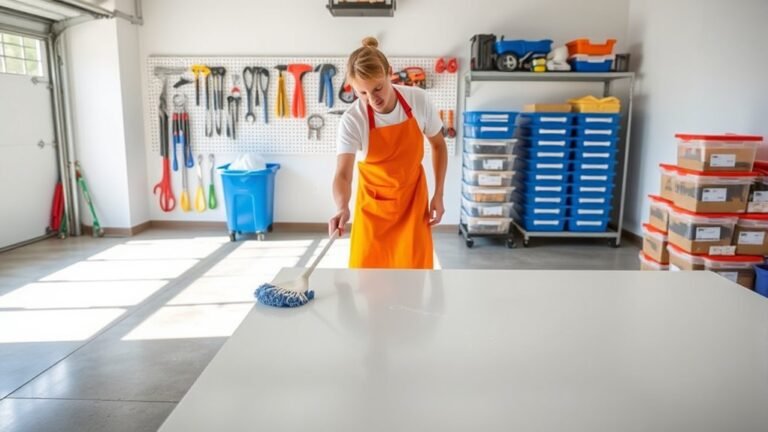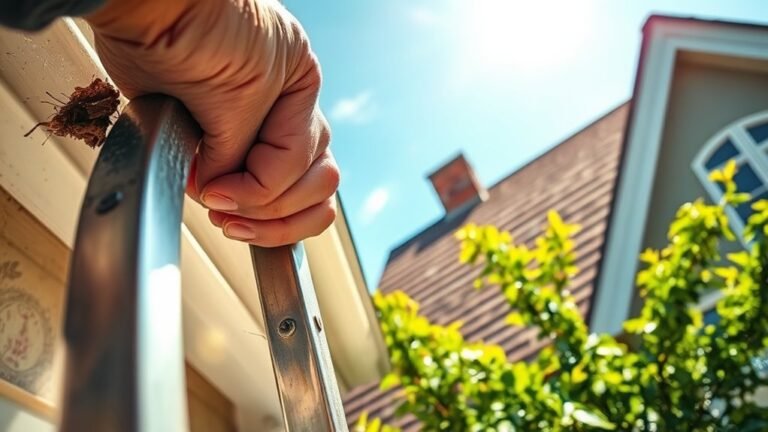Deep Cleaning Guide for Tile Flooring
To deep clean your tile flooring effectively, start by identifying your tile type—ceramic or porcelain—as each needs specific care. Use a pH-neutral cleaner and a stiff nylon brush to target grout lines after sweeping debris. Treat stubborn stains with a baking soda poultice, and remove mold with a diluted bleach solution, rinsing thoroughly afterward. Regular sealing and preventive maintenance help maintain shine and durability. Explore detailed steps and best practices to guarantee lasting tile beauty and cleanliness.
Understanding Different Types of Tile Flooring
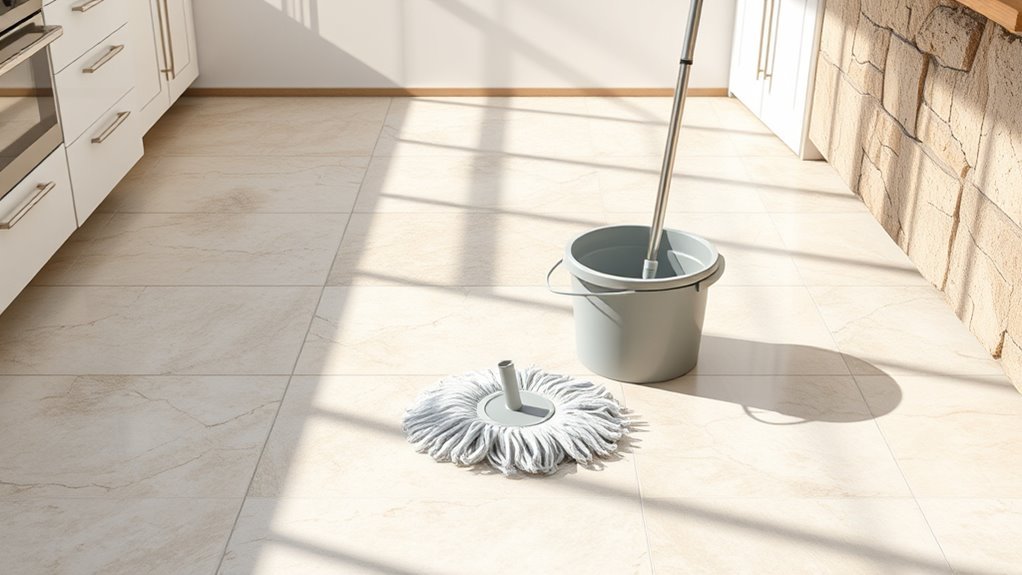
Before you begin cleaning, it’s essential to understand the specific type of tile flooring you have, as each material requires different care methods. Ceramic tiles, made from clay and fired at moderate temperatures, feature a porous surface that may need sealing to prevent moisture absorption. Porcelain tiles, however, are denser and fired at higher temperatures, making them more water-resistant and durable. Knowing this distinction helps you select appropriate cleaning techniques and products, ensuring you don’t damage the surface or grout. For ceramic tiles, avoid abrasive cleaners that can erode the glaze, while porcelain tiles tolerate more rigorous cleaning but still require pH-neutral solutions to maintain their finish. By identifying your tile type precisely, you maintain both its aesthetic appeal and structural integrity, giving you the freedom to enjoy your floors without worry.
Essential Tools and Cleaning Products for Deep Cleaning
To achieve a thorough deep clean on your tile flooring, you’ll need a specific set of tools and cleaning products designed for the task. Proper cleaning equipment guarantees effective tile maintenance without damage. Focus on items that target grout and surface dirt while preserving tile integrity.
| Tool/Product | Purpose | Recommended Features |
|---|---|---|
| Scrub Brush | Agitates dirt in grout lines | Stiff nylon bristles |
| Microfiber Mop | Cleans tile surface | Non-abrasive, absorbent |
| pH-neutral Cleaner | Removes stains without damage | Eco-friendly, non-corrosive |
| Grout Cleaner | Deep cleans grout | Penetrates stains, non-toxic |
Selecting these guarantees you maintain freedom from harsh chemicals while achieving ideal tile maintenance results.
Step-by-Step Deep Cleaning Process for Tile and Grout
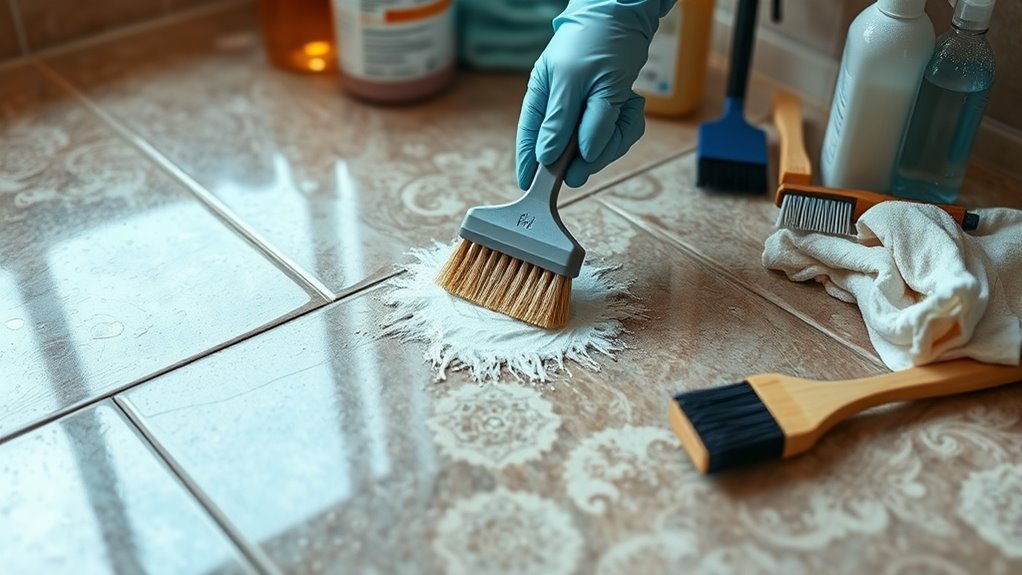
With the right tools and products at hand, you can proceed to the systematic cleaning of your tile and grout. Start by sweeping or vacuuming to remove loose debris. Then, follow these precise steps for ideal results:
Begin with sweeping or vacuuming to clear debris before systematically cleaning your tile and grout for best results
- Apply a suitable cleaner to grout lines and let it sit briefly to break down dirt.
- Scrub grout using a firm brush, focusing on deep crevices without damaging tiles.
- Rinse thoroughly, dry, and apply grout sealing to protect from future stains.
Afterward, polish your tiles with a specialized tile polishing agent to restore shine and durability. This step-by-step process guarantees your flooring remains pristine and long-lasting, giving you the freedom to enjoy a clean space without constant maintenance hassles.
Removing Stubborn Stains and Mold From Tiles
Although regular cleaning keeps tile surfaces generally spotless, stubborn stains and mold often require targeted treatment to be fully removed. For effective stain removal, apply a poultice made of baking soda and water directly onto the affected tile. Let it sit for 10-15 minutes before scrubbing gently with a nylon brush to avoid scratching. For mold, use a diluted bleach solution (1 part bleach to 10 parts water) applied carefully with a sponge, allowing it to penetrate grout lines and tile pores. Rinse thoroughly with clean water to prevent chemical residue. Always wear gloves and maintain proper ventilation during this process. By addressing these issues precisely, you’ll maintain your tile’s integrity while effectively removing stains and implementing mold prevention strategies, freeing you from recurring deep cleaning challenges.
Preventive Measures to Maintain Clean and Shiny Tiles
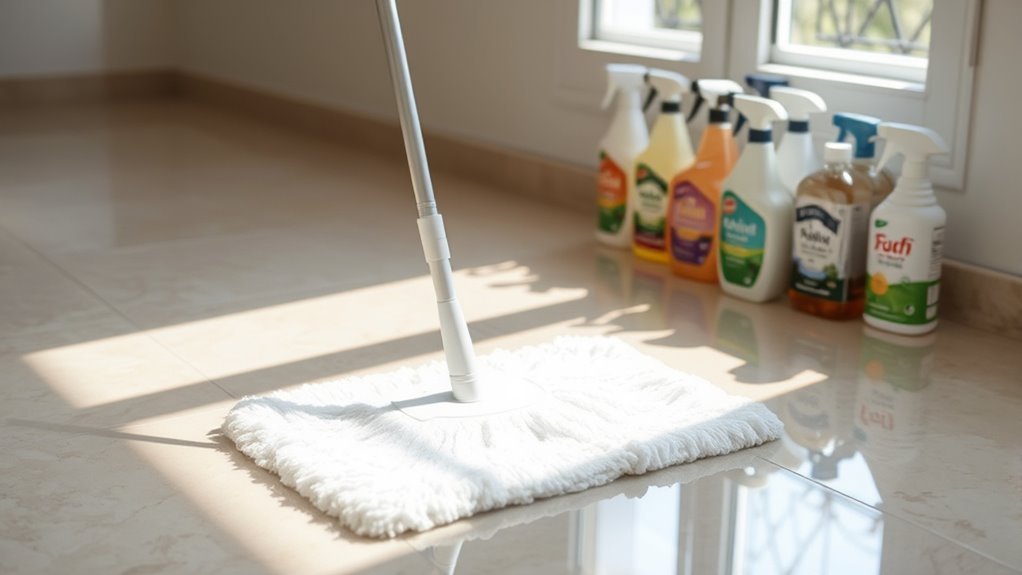
Even if you’ve thoroughly cleaned your tiles, neglecting preventive measures can quickly lead to dullness and buildup. Effective tile maintenance hinges on establishing a strategic cleaning frequency and adopting habits that minimize dirt accumulation. To maintain clean and shiny tiles, focus on these key practices:
Consistent cleaning and preventive habits are essential to keep tiles bright and free from buildup.
- Use entryway mats to reduce dirt and grit tracked onto tile surfaces.
- Implement a regular sweeping or vacuuming routine to prevent abrasive particles from scratching tiles.
- Apply a sealant periodically to grout lines to resist stains and moisture infiltration.
Frequently Asked Questions
Can Tile Flooring Be Deep Cleaned Using Natural Remedies Only?
Yes, you can deep clean tile flooring using natural cleaning solutions. Eco friendly methods like vinegar, baking soda, and lemon juice effectively remove dirt and grime without harsh chemicals. These ingredients break down residues and disinfect surfaces, maintaining your floor’s integrity while being safe for your environment. By choosing these options, you’re embracing a non-toxic, sustainable approach that aligns with your desire for freedom from synthetic cleaners and their potential health risks.
How Often Should Professional Deep Cleaning Be Scheduled for Tile Floors?
Frequency recommendations for professional deep cleaning of tile floors typically suggest every 12 to 18 months. Your cleaning frequency depends on foot traffic and environmental factors. If your space experiences heavy use, scheduling deep cleaning annually guarantees ideal maintenance. For lighter use, extending to 18 months works well. Regular professional cleaning preserves grout integrity and tile appearance, giving you the freedom to enjoy your floors without constant upkeep worries.
Are There Specific Tile Types to Avoid Deep Cleaning Chemicals?
Imagine you’ve got ceramic tiles in your kitchen; these handle most cleaners well. However, if you have porous tiles like unglazed terracotta, you should avoid harsh chemicals—they can seep in, causing damage. For ceramic tiles, mild, pH-neutral cleaners work best, preserving their finish. Always check the tile’s porosity before choosing a cleaner, ensuring you protect your flooring without restricting your cleaning freedom or risking deterioration.
What Is the Best Way to Protect Tile Grout From Future Stains?
To protect tile grout from future stains, you should apply grout sealing regularly. Grout sealing acts as a barrier, preventing moisture and dirt from penetrating the porous grout surface, which is essential for effective stain prevention. Make sure the grout is clean and dry before sealing. Reapply the sealant every 6-12 months, depending on foot traffic and exposure. This proactive approach keeps your grout looking fresh and extends its lifespan without limiting your cleaning freedom.
Can Deep Cleaning Damage the Finish or Sealant on Tiles?
When you perform tile maintenance, using harsh cleaning techniques can indeed damage the finish or sealant on your tiles. It’s essential to avoid abrasive tools or acidic cleaners that erode protective layers. Instead, opt for pH-neutral solutions and soft brushes to preserve your tile’s integrity. Proper cleaning methods not only keep tiles looking fresh but also extend the life of sealants, giving you freedom from frequent repairs or replacements.
